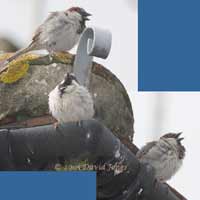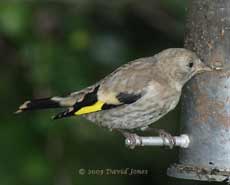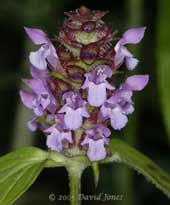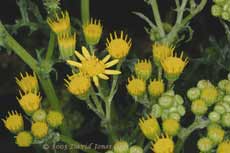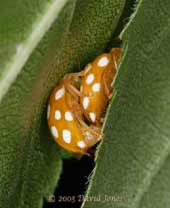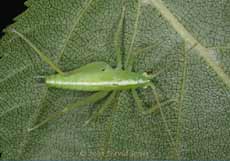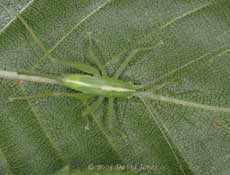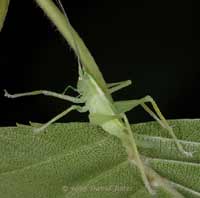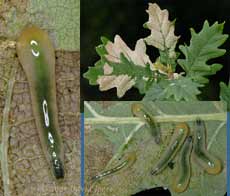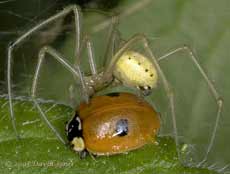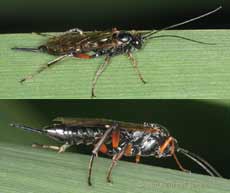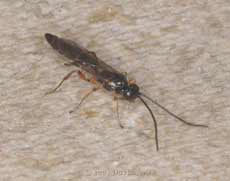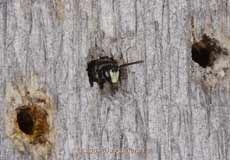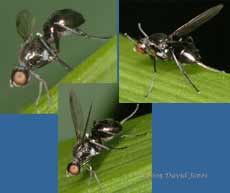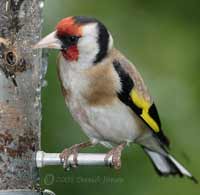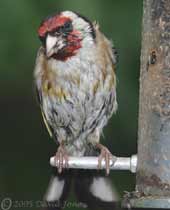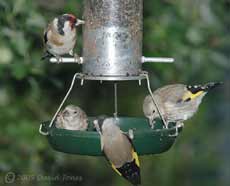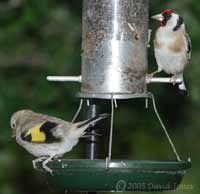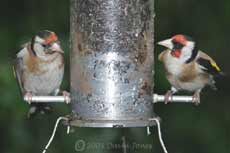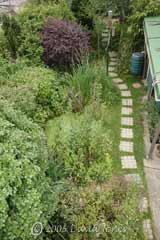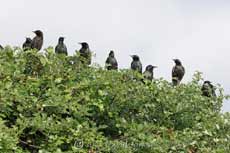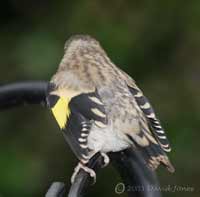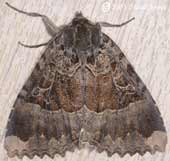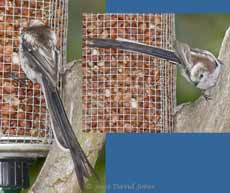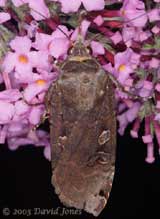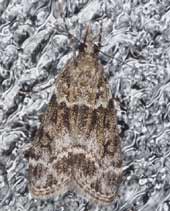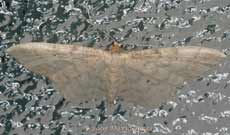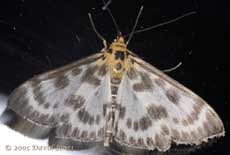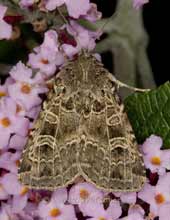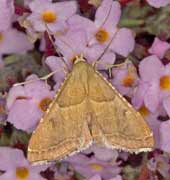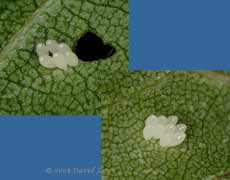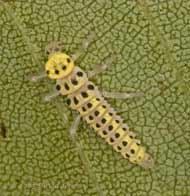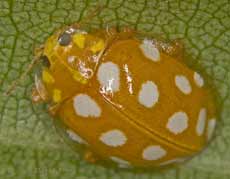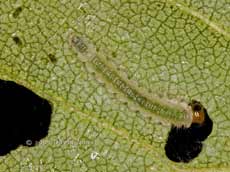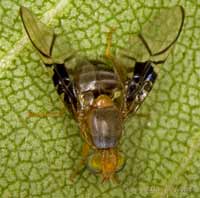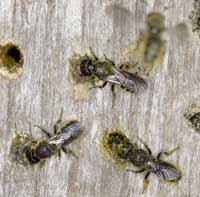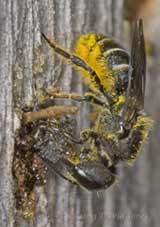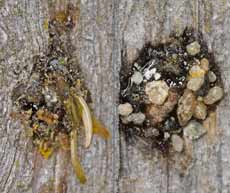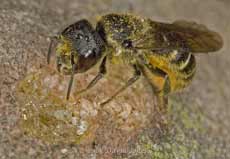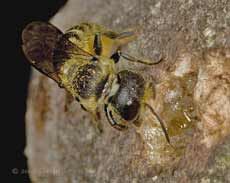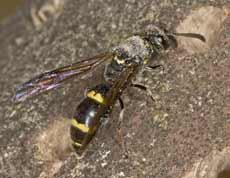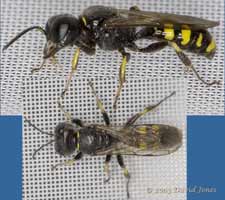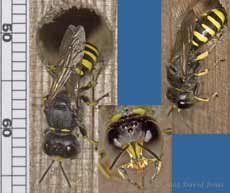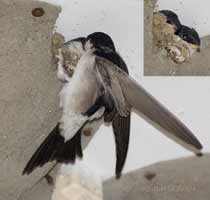Go to the last entry on this page .....Go to previous entry
4 July - US Independence Day - and the day when 'Deep impact' made its impression on a distant comet - an amazing achievement. Here, we seem to have lost sight of Summer for the moment, and over the last few days it has been cloudy and cool, although there has been just a little rain. I've been in one of those energy troughs caused by the CFS which is why this month's diary is a bit slow to get going. First, two great bits of bird news - Firstly, The Blackbirds have started another brood! On the 1st and 2nd they continued to take food away at the same time as the female built her new nest. Yesterday the pattern changed and only the male collected mealworms for the still unseen youngster(s). His partner wasn't seen at the nest at all and only appeared under the Hawthorn in the late afternoon when she ate but took nothing away. This morning I caught sight of a healthy looking young Blackbird for the first time, although it disappeared into the shrubs very quickly. Dad is still collecting mealworms for it, and mum is sitting in the nest (at 10.30am). There were no eggs in the nest yesterday so I presume she is now starting her egg laying. This afternoon I confirmed the appearance of a single egg - perhaps that is why she was feeding a lot yesterday afternoon? The second bit of news concerns the House Martins, although its a bit of a mixed story. I recorded a four hour video sequence this morning. During that time there was no activity at all around the left hand box, and I beginning to wonder if the birds I have seen there have been using it just for roosting. The right hand box is definitely in use, but the video recorded just one event when a bird left the box about half way through the recording and had not returned before the tape ran out. However, it's very different in the middle nest. Both parents were active throughout the four hours of video. A bird arrived 22 times, usually exchanging places with the partner who was already in the nest, and although I couldn't see anything in their beaks, I assume they were bringing food. The fact that there are chicks in the nest was confirmed when I saw a parent drop a couple of faecal sacs out of the entrance, followed by a third about twenty minutes later.
As far as next-doors' Swifts are concerned, it's difficult to tell what is going on as visits are few and far between. In fact, the greatest level of activity outside the nest entrance involves one of our local Sparrows. This composite image shows a male who seems desperate to intimidate any Swift that comes close. You couldn't help but notice it as it chirped loudly from different vantage points around the nest entrance (below the curly metal bit!).
Tonight I redirected the cctv camera from the Martins to the Swifts' corner to check that they are still using the nest. I'm pleased to confirm that despite the efforts of the Sparrow earlier in the day, I recorded a swift leaving the nest at 8.10pm and one entering at 9.20pm. There was no further activity prior to my checking the video at 10.30pm. The House Sparrows seem to have far less interest in collecting mealworms now. I did see a chick looking out of the nest yesterday, but this morning I've not seen activity at the box and although I haven't seen any fledglings in our garden, I'm wondering if the chicks have fledged.
For some reason, we have hardly seen the Goldfinches today, whereas for most of yesterday they could be heard or seen around the garden. This picture of a juvenile was taken two days ago and shows the contrast between the mottled front and the bold wing colours.
Two more plants have come into flower over these last few days. First, the Self-heal plants are now starting to provide their purple colour to the lower levels of greenery around the pond.
Yesterday, the first Ragwort flowers have unfurled their petals. It is curious how the flowers spend several days with the petals resembling a crown before they finally open completely.
I found two more individuals on the tree.
The night before last, I had seen three Orange Ladybirds, but the highlight of that session was the appearance on the tree of two crickets (which I haven't seen since). There were on the same branch, just a few leaves apart. These are infrequent visitors to the garden, and I think they are possibly immature Oak Bush Crickets, and this one is a male.
The long ovipositor on the second cricket indicates that it is a female.
This second image shows the ovipositor more clearly.
Some time back, I commented about the galls that had appeared on my Sessile Oak tree (in a pot). These have shrivelled away completely, but now a few of its leaves have fallen victim to the ravages of a saw fly's larvae. These larvae are known as Oak Slug worms. Although they appear quite slug-like, they do have reduced legs. They are the larvae of a sawfly, probably Caliroa annulipes. The larvae work on the undersides of leaves, eating all the soft tissues and leaving these areas skeletonised, but leaving the upper surface untouched. While we are starting to see Orange Ladybird activities on the Birch, over the rest of the garden, ladybird (and ladybird nymph) numbers appear very low after the variety that appeared earlier in the year. There are plenty of aphids about, so ladybirds and their should have 'easy pickings'. However, they don't always get their own way.
Here, a Two-spot Ladybird has blundered into one of the many webs that coat the upper parts of plants around the garden. It seemed to present an interesting challenge for the spider, which eventually got around the ladybird's hard exterior by attacking the tail-end of its abdomen. A few minutes later it was taken into the heart of the web, under a partly folded leaf.
Finally, four insects captured on camera over the last three days -
First is this sawfly(?) that appeared on an Iris leaf, staying just long enough to capture these two images. Its body was about 14-15mm in length.
Next, there were several of these smaller insects, less than 1cm in length flying around the base of the Oak tree pot, staying very near the ground.
An exception yesterday afternoon came in the form of this yellow face looking out from one of the 2.5mm holes. I can remember seeing this solitary wasp before, but I need to search for the ID which I was given at that time.
(added on 5 July -) I've now found the info about this little visitor. It's not a wasp, but a member of a group of bees known as 'Yellow-faced mining bees' or 'masked bees'. It is probably a male Hylaeus communis. The females are unusual in that they have no external means to carry pollen. Instead, they ingest it and then regurgitate it from its crop (along with nectar) when back at the brood cell. This is usually in existing holes in timber, plant stems and sometimes in the soil.
You had to look closely to see this last one. This was a tiny black fly that spent its time waving its wings furiously as it ran about on Iris leaves. This habit, along with its wing venation suggests that it is either a Sepsis fulgens, or a close relative.
Finally, a note about today's weather. There was a thunderstorm with a heavy downpour and hail at lunchtime. When that eased off I spent time out on the veranda throwing mealworms to the frogs that had gathered under the Hawthorn. At that time the temperature was around 15C. Later in the afternoon there was another heavy shower, and the temperature dropped to nearer 10C. After that rain stopped there was not a frog in sight - I can only assume they don't like the cold!
5 July - Another dull, cold day in prospect (15C at 11am). Despite this, the Blackbird is sitting in her nest this morning. I'm not sure if she was there over-night. I tried checking the nest using an image intensifier at around 10.30pm and I couldn't see her tail sticking up, although it was difficult to see through the foliage which shows up very brightly through the intensifier. I recorded another four hours of House Martin video from 8am. This time there was no movement at all seen from the left and right nests. The middle nest showed all the signs of young chicks being fed and incubated. There was a total of nineteen arrivals at the nest, with eleven of these involving a swap of adults, with one leaving moments after the partner had entered. There was an adult in the nest for 2hr 27min of the 4 hours. The nest was left unattended eight times, for an average of nearly eight minutes.
7 July - The weather is trying to improve, and we have had some sunshine today, and a heavy downpour. Yesterday there was the great news that the 2012 Olympics are coming to London, and today the Capital has been hit by terrorist bombs that killed dozens of people - what a crazy world. One of my sons works each Thursday in the affected part of the City. Fortunately he had gone into work early, before the attacks took place. Back to the garden - I'm still having a problem with my energy levels so very little is being done. The Blackbirds also seem to having problems. Yesterday the female was sitting on the nest nearly all day, but today, although she comes to feed under the Hawthorn, I haven't seen her on the nest at all. This afternoon I checked the nest with a mirror and I cannot see any eggs. The nest doesn't look damaged, but it does look as though she has lost another clutch. In the meantime the male is still taking mealworms away. I'm still only seeing activity in the middle House Martin nest, so it looks as though we have only one growing family there so far. It's interesting to see how the House Sparrows have now resumed their interest in the seed feeder after several weeks of little or no interest. The young Robin appears frequently under the Hawthorn, and there was a Dunnock here again today. We get an occasional visit from the local (small) flock of Starlings and their offspring which are now feeding for themselves. The most obvious birds here at the moment are the Goldfinches which can be seen or heard almost all day. First thing this morning there were four adults and at least three youngsters here, although they didn't oblige by staying together for a photograph.
Later in the day I set up the camera on the veranda and captured numerous images, including the following - There are four adults that feed here regularly, and this is one of them.
Just before I set up to take the photographs we had a very heavy downpour, and while the first adult obviously found shelter, this one was less lucky, and looked rather sorrowful, as well as hungry.
There is a lot of wastage from the Nyger seed feeders so this week I have added some small trays to catch the spillage. The fledglings have taken advantage of the trays, and although the adults prefer the feeders themselves, they do take a few seeds from them.
The fledgling (bottom-left in this picture) has its head down, is fluttering its wings, and is swaying from side to side as it begs to be fed. The twittering that goes on when the family group is in the garden has a very 'bubbly' quality to it, and is far from the usual sound we usually hear.
Finally, back on the 16 May we saw the first Goldfinch fledglings of the year. In this picture the bird on the left could well be one of those birds, now developing the Goldfinch's characteristic head plumage.
9 July - After a cloudy start, the afternoon brought sunshine and a promise of even better tomorrow. There have been no further signs of the Blackbirds trying to nest. The male was still taking mealworms away yesterday, but he is now more interested in pecking at the apples I've thrown down under the hawthorn. Having confirmed that the nest is now abandoned, I decided yesterday afternoon to put up my scaffolding tower ready to clip the top of the Hawthorn, and I got the job done this morning, although I still need to get into my neighbour's garden to finish the job. There's no picture of my up the tower, but I did take the opportunity to get a few pictures of the garden from a different angle.
The local Starling flock obviously approved of the Hawthorn's new top. When I walked down the garden this evening they were lined up right over the top of it, enjoying the sunshine. Unfortunately, by the time I got my camera from the house some of them had headed up to the rooftops, but this picture still gives an idea what I saw.
Probably because of my activity in the garden, the Goldfinches have been less in evidence today. However, while we had our evening meal on the veranda an adult and fledgling arrived and we stopped eating for a few minutes to watch the youngster as it begged for food. As it swayed from side to side, fluttering its wings irregularly and twittering, the adult seemed to be ignoring the performance as it picked out, and split what must have been several dozen thistle seeds. Then, both birds flew up to the roof where the fledgling was fed. The adult was obviously collecting the seed kernels in its crop until there was sufficient to pass on.
This picture of the fledgling shows a bit more detail of its back and wing feathers.
Something else also caught our attention on the veranda this evening, the first sign of activity at the leaf-cutter bee 'hotel'. I noticed bits falling out of one of the bamboo tubes, a sure sign that a bee was having a 'spring clean'. As we watched, more and more fragments of dried leaf tumbled out and , eventually the rear end of a Leaf-cutter bee (Megachile centuncularis).
This picture was actually taken on the 7th, but I forgot to include it in the diary entry.
15 July - The present period of tiredness caused by the CFS continues to frustrate me, but at least the weather has been good these last few days. There has been no rain (which is not so good) and it has been very warm, with daytime temperatures approaching 30C, although it is supposed to be a bit cooler today.
The bird news - the Blackbird male was still taking away mealworms yesterday, and his partner has now all but 'vanished' again. I wonder if she has built yet another nest. A couple of days ago I got the distinct impression that there were two fledglings about. I though I could hear two, and then I saw one being fed below the Hawthorn before the male flew off to the bottom of the garden with a beakful of mealworms. At the front of the house, it is just the middle House Martin nest that is active, with both parents busy bringing food throughout the day. I had hoped to get my scaffold tower set up to take photographs, but I'm afraid I've had to abandon that plan this time. We are seeing far less of the Goldfinches now. They are still about, but their visits to the feeders seem to be restricted mainly to the early mornings.
Just one bird photograph to include this time. Over the last two days a single Long-tailed Tit has appeared several times at the tall peanut feeder, usually with a Blue Tit. Today I managed to grab a couple of images, including these that show why this little bird has got its name.
The warm sunshine has brought out more butterflies but they have so far avoided my camera. There have been Commas, Speckled Woods, Large Whites and a Tortoiseshell. By the time it's dark enough for the nocturnal moths appear I've just about given up for the night, however, last Saturday evening (9th - National Moth Day) I photographed four different types:
There were four of these Large Yellow Underwings, frequent visitors right through the summer months.
This was on the patterned glass of our kitchen door,
and so was this smaller moth which looks rather like a Common Wave.
This Small Magpie moth appeared on our patio door.
Last night I checked the Buddleia again and photographed just two examples. The first was a moth that looks very much like a Gothic
I haven't managed to identify this second moth.
I continue to monitor the Birch tree, and five days ago I spotted the first eggs that have been laid by the Orange Ladybirds. Since taking these photographs I've found one more group. All three groups are on leaves that are on low branches on the eastern side of the tree.
Having only just found these eggs, I was then surprised on the 11th to find this solitary Orange Ladybird larva scurrying around on the underside of leaves. Its size (around 7-8mm) means that it has been around for a while - I shall have to look for others.
I can how count at least a dozen adults, including this one at rest under a leaf. Its head is almost completely retracted under the pronotum (the hard covering of the thorax) and because this is almost transparent you can still see the eyes quite clearly. You can also see through the edges of the elytra.
Quite a few Birch leaves have holes in them, but I rarely see what is causing them. However, three nights ago I spotted this larva, which I guess is that of a sawfly.
On another leaf this fly was roosting. The wing pattern suggests that it is a Phagocarpus permundus. The larvae of this species develop in hawthorn fruits.
The warm, sunny weather has really encouraged the solitary bees and wasps to become very active now. The leaf-cutter bees continue to emerge, and the bee photographed on the 9th has completely sealed the first tube today.
At the original bee hotel, activity is becoming quite frenetic as the most of the holes have now been filled. The flowering of the Ragwort has certainly provided a valuable local source of pollen.
It's fascinating to watch the bees as they seal the holes. They seem to regurgitate what looks like honey, and which is used to stick together a variety of items to close up the entrance.
These two images show variations in approach to finishing the job. The left-hand plug appears to be decorated with a variety of plant fragments, while the bee creating theright-hand plug has used grains of sand to create a 'pebble-dash' effect on a 'dark treacle' base.
I have now set up a new bee hotel, using a long, dead and quite rotten tree branch. I drilled two groups of holes in it, one using 3mm and the other 4mm drills.
This picture shows one of the first bees to complete this task. You can see the light-coloured material that it is using to do the sealing.
This second image of the same bee is included because it give a rare chance to see the unprotected neck of the bee.
A near neighbour of the bee, this solitary wasp was also busy sealing its nesting hole. As seems typical of these wasps, its hole is closed up with a fine mud 'mortar' which usually dries to blend in very well with the suroundings.
A couple of centimetres away another solitary wasp has also moved into a 3mm hole. The light powder that has coated its thorax is dust from the holes it has been examining.
This wasp entered the house a few days ago.
A few larger solitary wasps can be seen flying about the garden at the moment. This one was spotted as it prepared to reverse into an 8mm hole in another bee hotel that is tucked away in front of the workshop shed and under the shade of the Birch tree.
While the solitary species are very busy at the moment, we are seeing very few Bumble bees and no social bees or wasps.
19 July - Today was the coolest for a while. I'm afraid that I'm still finding it difficult to get things done and I've hardly picked up my camera since the last diary entry. Anyway, we have decided to 'abandon ship' again for a while and head for our caravan down in Cornwall, so the gap in the diary will grow again until we return. As before, I hope to keep the diary going while we are there and then add those pages as soon as we get home.
Over the last few days we have seen the chicks for the first time. This evening I spent some time watching the nest and captured this shot of one being fed, and the insert shows two chicks looking out for their next feed. Last year the Martins nested after we returned from our summer break. That must have been a second brood, so I shall keep my fingers crossed that a similar thing happens this time.
In the garden, the Goldfinches are now just occasional visitors again, and the male Blackbird is still taking food away, and his partner only appears occasionally, making me wonder if she is trying to nest yet again. Click on the images to see larger versions - |
|
